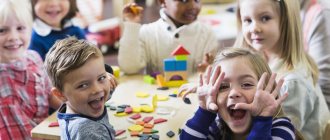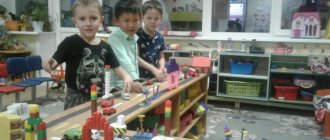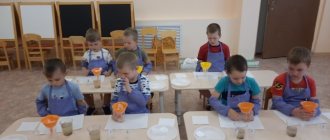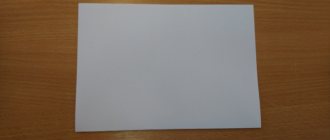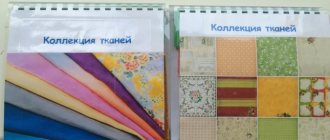Development of cognitive-research and productive (constructive) activity of preschool children.
The cognitive-research activity (or exploratory behavior) of a preschooler manifests itself in the form of so-called “children’s experimentation” with objectsb or questions asked to an adult (Why? Why? How)
Exploratory behavior is one of the most important sources of a child’s understanding of the world, and exploratory learning is built on the basis of the child’s natural desire to independently study the environment.
All educational activities are based on integration and thematic planning. Consequently, preparing a child for research activities, teaching him the skills and abilities of research become the most important tasks of modern education.
Everyone knows that in preschool children visual-figurative thinking predominates, therefore observations of inanimate nature play an important role in the system of presenting material on cognitive activity.
A well-conducted thematic conversation using illustrations, slides, and layouts also contributes to the accumulation of knowledge about the laws of the surrounding world.
Experiments are one of the most interesting and favorite activities for children, where conversations and observations are intertwined. Experiments also contribute to the development of such thought processes as analysis, synthesis, and comparison.
Well, and of course, the most important type of children's activity, which allows children to carry out research activities in a relaxed manner, is play .
Taken together, all 4 types of activities contribute to the development of cognitive and research activities, curiosity, mental processes: memory, thinking, attention, speech, perception, imagination.
And this is the concept of the comprehensive development of the child’s personality, which is of great importance in the child’s further education at school.
Main goals:
1. Create a system of work in the educational field “Cognition” in the section of cognitive and research activities of children;
2. Present all the material in special types of children's activities;
3. Preparing preschool children for research activities, teaching them the skills of research.
The main types of children's activities in the preschool period are playful and productive. Productive activity in preschool education is the activity of children under the guidance of an adult, as a result of which a certain product appears.
Numerous studies have shown that it is productive activity that contributes to the development of graphic skills in children of senior preschool age, fosters perseverance, creates pedagogical conditions for the process of socialization of senior preschoolers and, along with play, is of greatest importance for the development of the psyche during this period.
Research in recent years shows that the number of children with delays in speech and personal development is growing. As you know, children’s speech directly depends on the fine motor skills of their fingers.
Engaging in productive activities develops the child’s creative imagination, promotes the development of hand muscles, coordination of movements, and develops thinking skills (analysis, synthesis, ability to compare).
Productive activity, like any cognitive activity, is of great importance for the mental education of children.
When conducting classes, favorable conditions are created for the formation of such qualities as inquisitiveness, initiative, curiosity and independence.
Productive activity has an impact on the comprehensive education of a preschooler.
It is closely related to sensory education. The formation of ideas about objects requires the assimilation of knowledge about their properties and qualities, shape, color, size, position in space.
In the process of productive activity, mental and physical activity are combined. To create a drawing, sculpting, or appliqué, it is necessary to make efforts, carry out labor actions, and master certain skills.
Preschoolers master many practical skills that will later be needed to perform a variety of jobs and acquire skills that allow them to feel independent.
In productive activities, an integrated approach is successfully implemented. Classes allow you to relieve stress and fears of children.
Productive activity, modeling objects of the surrounding world, leads to the creation of a real product, in which the idea of an object, phenomenon, situation receives material embodiment in a drawing, design, three-dimensional image.
Productive activities of a preschooler include visual and constructive activities. Fine art activities include drawing, modeling, and appliqué.
Construction is a practical activity that consists of connecting individual parts in order to obtain a certain whole object. The emergence of constructive activity depends on the level of development of perception, play activity and thinking, as well as on the development of motor skills, cognitive activity and communication. In addition, design classes influence: physical education - actions with materials for design develop subtle finger movements, influence coordination of movements, spatial orientation, moral and aesthetic education - we teach children to see the beauty in what they do, develop taste, at the same time introducing architectural forms; and in the process of making gifts for the holidays, we form a caring and caring attitude towards loved ones, a desire to please them, labor education - the process of classes forms in children purposefulness, independence, initiative and organization.
Of course, first of all, constructive activity is essential for mental development. Thanks to it, children learn the external properties of objects (color, shape, size, their physical qualities (stability, density, weight), learn to compare and connect them with each other, enrich their ideas about the world around them, develop speech and creative abilities. It is also worth noting that constructive activity is one of the effective ways to prepare for school: developing the qualities necessary for learning, it does this completely unobtrusively, since it is attractive and interesting for children.Activities with building materials develop creative initiative and imagination.
The following types of design exist:
• from building material,
• sets of constructors,
• papers,
• natural and other materials.
Construction from play building materials is the most accessible and easiest type of construction for preschoolers.
By constructing from building materials, children become familiar with geometric three-dimensional forms and gain an understanding of the meaning of symmetry, balance, and proportions.
Construction from paper, cardboard, boxes, spools and other materials is a more complex type of construction in kindergarten. When designing from paper, children's knowledge of geometric plane figures, concepts of sides, angles, and center are clarified. The children learn the techniques of modifying flat shapes by bending, folding, cutting, gluing paper, resulting in a new three-dimensional shape. The fundamental point in design is the analytical and synthetic activity of examining objects.
Construction from natural materials is closer in nature to the artistic type. It develops creative imagination. Important conditions for organizing design training include:
• organic relationships with other types of activities (dramatization games, drawing, writing funny and sad stories, etc.);
• targeted excursions to a park, forest park, forest;
• creating in children an attitude towards independent search through the special position of the teacher - “not to teach, but to cooperate” (support the child’s initiative, help and suggest if necessary).
Construction, more than other types of activities, prepares the ground for the development of children's technical abilities, which is very important for the comprehensive development of the individual. During classes in drawing, modeling, appliqué and design, children’s speech develops: the names of shapes, colors and their shades, spatial designations are learned, and their vocabulary is enriched. In the process of analyzing the work, at the end of the lesson, children talk about their drawings, modeling, and express judgments about the work of other children. In drawing, modeling, and appliqué, children convey their impressions of the world around them and express their relationships to it. Visual activity can only acquire a creative character when children develop aesthetic perception, imaginative thinking, imagination and when they master the skills and abilities necessary to create an image.
24. Sensory education in preschool educational institutions: concept, meaning, objectives, content, methodology.
In the psychological and pedagogical dictionary, sensory education
(from Latin sensus - feeling) is interpreted as the purposeful development and improvement of sensory processes (sensations, perceptions, ideas).
Sensory processes represent the first stage of cognition and form the area of sensory cognition, therefore sensory education often acts as the initial link in mental education.
In the process of sensory education, the transition from sensory to rational knowledge, from perception to thinking is prepared, and the basis for subsequent intellectual activity is formed. At the same time, the development of sensory processes plays a significant role in improving the child’s practical activities. Sensory education includes the formation of the perception of shape, size, spatial relationships between objects, color, as well as musical ear, improving the sound analysis of speech, etc.
The period of preschool childhood is a period of intensive sensory development of the child - improving his orientation in the external properties and relationships of objects and phenomena, in space and time. Perceiving objects and acting with them, the child begins to more and more accurately assess their color, shape, size, weight, temperature, surface properties, etc. When perceiving music, he learns to follow the melody, distinguish the relationships of sounds in pitch, and grasp the rhythmic pattern; when perceiving speech, he learns to hear the subtlest differences in the pronunciation of similar sounds.
Children's ability to determine direction in space, the relative position of objects, the sequence of events and the time intervals separating them is significantly improved. The importance of sensory education was well understood by prominent representatives of preschool pedagogy: F. Frebel, M. Montessori, O. Decroli, E.I. Tikheyeva, L.A. Wenger, N.N. Poddyakov and others. The sensory education system was developed on the basis of modern didactic principles.
Based on the first principle
It is necessary to enrich and deepen the content of sensory education, which presupposes the formation in children, starting from an early age, of a broad orientation in the subject environment.
Second principle
involves a combination of teaching sensory actions with various types of meaningful activities for children, which ensures deepening and specification of pedagogical work, and allows one to avoid formal didactic exercises. Thus, improving sensory education should be aimed at clarifying the meaning of the properties of objects and phenomena or clarifying their “signal meaning”.
The third principle
it is predetermined that children will be given generalized knowledge and skills related to orientation in the surrounding reality.
Fourth principle
involves the formation of systematized ideas about the properties and qualities, which are the basis - the standards for examining any subject, i.e. the child must correlate the information received with his or her existing knowledge and experience. The sensory development of a preschooler includes two interrelated aspects, which in turn act as the tasks of sensory education: 1) to ensure the accumulation and assimilation of ideas about the various properties and relationships of objects and phenomena;
2) mastering new perceptual actions that allow us to more fully and comprehensively perceive the world around us.
The main task
sensory education
is to develop in children such skills to perceive and imagine objects and phenomena that would contribute to the improvement of the processes of drawing, design, sound analysis of words, work in nature, etc.
The role of the teacher is mainly to reveal to children those aspects of phenomena that may go unnoticed, and to develop children’s attitude towards these phenomena.
Thus, sensory education should be carried out in inextricable connection with a variety of activities.
Contents of sensory education
The content of sensory education includes a wide range of signs and properties of objects that a child must comprehend throughout preschool childhood.
Traditional content has developed in sensory education
. This is an acquaintance with color, size, shape, taste, smell, texture, heaviness, sound of objects in the surrounding world, and orientation in space. In this case, the task is to increase the sensitivity of the corresponding analyzers (development of tactile, visual, olfactory, auditory and other sensitivity), which manifests itself in distinguishing the signs and properties of objects. At the same time, the child learns to name the properties of objects (soft, hard, fluffy, rough, cold, warm, hot, bitter, sweet, salty, sour, light, heavy, below - above, close - far, right - left). In the domestic system of sensory education, the traditional content is expanded and supplemented by including orientation in time, the development of speech and musical hearing.
Orientation in time
assumes that the child acquires ideas about parts of the day, days of the week, months, year, and the fluidity of time.
Speech (phonemic) hearing
is the ability to perceive speech sounds, differentiate and generalize them in words as meaningful units. The development of phonemic hearing is associated with mastery of sound pronunciation norms. The level of development of phonemic hearing manifests itself when a child is learning to read and write, when he is faced with the task of sound analysis of a word. This means that he must move away from the meaning of the word, its meaning and work with the word as a sound complex, that is, a formal unit.
Ear for music
- this is the ability to distinguish sounds by pitch, timbre, rhythmic pattern, melody.
Thus, the content of sensory education consists of sensory standards
- generalized sensory knowledge, sensory experience accumulated by humanity over the entire history of its development; generally accepted examples of each type of properties and relationships of objects. So, in the area of shape - these are geometric shapes (circle, square, triangle, etc.), in the area of color - seven colors of the spectrum, white and black. The external qualities and properties of objects in the surrounding world are extremely diverse. In the course of historical practice, systems of those sensory qualities that are most significant for a particular activity have been identified: systems of measures of weight, length, directions, geometric shapes, color, size; norms of sound pronunciation, system of sounds in height, etc. Each sensory standard has its own verbal designation: measures of weight, measures of length, color spectrum, arrangement of notes on the staff, planar and volumetric geometric figures, etc.
The assimilation of sensory standards is a long and complex process, the main burden of which falls on older preschool and school age. In the first years of life, children develop the prerequisites for sensory standards. From the second half of the first year to the beginning of the third year, so-called sensorimotor prestandards
.
During this period of life, the baby displays individual properties of objects that are essential for his movements. At preschool age, the child uses so-called subject standards
: he correlates images of the properties of objects with certain objects.
In the first year of life, the tasks of sensory education (development of hearing, vision, formation of objectivity of perception) are successfully solved in manipulative and objective activities. In the future, rich opportunities for sensory development are fraught with such types of activities as play, work, constructive, and visual arts. Each of these activities has its own sensory basis.
Since in early childhood the task of children mastering generally accepted standards is not yet set, training should not include mandatory memorization of the names of individual colors and shapes. In the second year of life, the technique of “objectifying” shape and color leads to successful completion of tasks. Training should not be carried out on countless varieties of properties, since in this case the necessary soil will not be created for subsequent mastery of the system of standards. Since this system primarily includes the primary colors of the spectrum (red, orange, yellow, green, blue, indigo, violet, white and black), 5 shapes (circle, square, rectangle, triangle, oval), 3 varieties of size (large, medium , small), then the child should first of all develop ideas about these figures, color tones, sizes, but without a general meaning.
Therefore, it is advisable to include the above colors (8 when considering blue as a shade of blue), 5 figures and two sizes (large, small) into a program for systematically familiarizing yourself with the properties of objects in early childhood.
Training should include the formation in children of generalized methods for examining many qualities that serve to solve a number of similar problems. Correlating and comparing objects with each other is precisely a generalized method that is formed at the stage of early childhood and allows one to successfully solve a certain range of problems in distinguishing color, shape, and size.
Since in early childhood the task of children mastering generally accepted standards is not yet set, training should not include mandatory memorization of the names of individual colors and shapes. In the second year of life, the technique of “objectifying” shape and color leads to successful completion of tasks. The basis for introducing the objectification of properties and the assimilation by children of their signal meaning is provided by elementary actions of a productive nature, which children begin to master at the age of two. For example, already in the third year of life, children can be taught to apply color spots that convey the specifics of certain objects and phenomena; they can use colored mosaics.
It should be noted that speech plays a great role in the development of sensory cognition. The adult’s word records the sensory experience acquired by the child and generalizes it. Verbal designations of the signs and properties of objects contribute to their meaningful perception and clear distinction.
Thus, the main content of sensory education in kindergarten and in everyday life is to familiarize children with sensory standards and enrich them with ways to examine objects.
At the intersection of content and methods of sensory education, methods of sensory development should be emphasized:
- practical method (overlay, application, trying on);
— visual relationship (practical methods are a perspective for the development of actions).
A.V. Zaporozhets identifies the stages of sensory development: 1. Transition to externally oriented action.
2. Expanded perspective of action.
3. Stage of connecting promising actions.
In accordance with the stages, the levels of sensory development are considered according to the years of a child’s life:
1 - the main task is to provide the child with the maximum opportunity for sensory sensations;
2 - practical assimilation of sensory sensations through testing, correlation of objects;
3 - manipulation function: color relationship, object-productive, verbal activity;
4 - transition from substantive activity to normative;
5 - the concept of the color spectrum, systematization and consolidation of the concept of geometric shapes, size parameters;
6 - the formation of ideas about primary and additional colors, lightness, geometric shapes, size parameters, analysis of complex shapes of an object.
